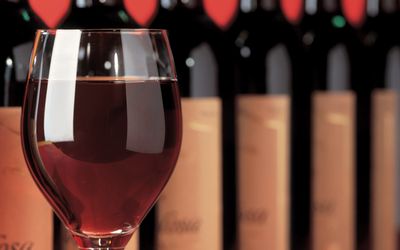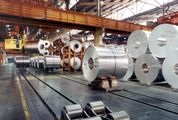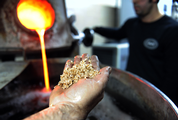THE 2016 harvest is in full swing — and so is the 2016 Western Cape fire season. So far the grapes have had the worst of the two encounters — against the elements, struggling with heat and drought, and against the arsonists, battling smoke and flames. It was never going to be an easy vintage.
The winter was one of the driest on record, so the water table was low and the dam levels lower still. In areas where dryland vineyards predominate — the Swartland is the most important example — crop size predictions are constantly being scaled down. The berries have stayed small, and without rain or adequate ground water, have remained stunted in size. Small grapes aren’t necessarily a bad thing: they can produce higher skin-to-juice ratios, with a higher percentage of flavonoids after pressing and maceration. However, this presupposes evenly and fully ripened fruit. Serious water stress leads to the vine "shutting down", conserving itself at the expense of the evolution of the grapes. The result is that the sought-after phenolic development doesn’t occur — not before the acids begin to drop and the berries dehydrate and wrinkle. In short, fruit and flavour dies stillborn.
You can expect this year’s vintage will be significantly smaller than the last few harvests, and while some producers (those with a perfectly managed viticultural environment and access to adequate water supplies) may make wonderful wine (Vilafonte has issued a release celebrating the measurably even ripening), the vast majority will be less sanguine.
Add to this the fires that have distracted the producers in Elgin and wrought havoc in the prime vineyard areas of Stellenbosch and you can see why many producers may apply Her Britannic Majesty’s choice turn of phrase in describing this year as an "annus horribilis."
While the fires made the news briefly, they succumbed swiftly to the political circus. Assumptions such as "nature running its course", the "self-regenerating potential of fynbos", and "rich wine farmers who don’t deserve much sympathy" don’t exactly give traction to their media value.
However, at least insofar as the Elgin and Stellenbosch fires are concerned, it’s important to dispose of these myths. For a start, it’s suspected that neither were natural combustions: on the contrary, there’s much to suggest they were the work of arsonists. Disregarding malicious damage to property is to disregard the property rights clauses in our Constitution.
As it happens, none of the farms affected by the fires can shrug off the losses: they may seem like big enterprises, but even the fine wine business is marginal.
The truth is, we came within a puff of wind of losing estates that are national treasures. We lost significant amounts of prime vineyard and hundreds of tonnes of the region’s best grapes. Since it is clear that the fire department did not act as swiftly as it could have, the Western Cape administration should bear its share of liability for the failure of the regional fire chief to act in the appropriate manner.
As for the environmental question: while it is true that fynbos — which is a fire hazard — can and does recover from fires, this assumes that wine estate proprietors will continue to tolerate its presence in the midst of their agricultural enterprises. The Cape wine industry has been at the forefront of sound environmental management, with the Biodiversity and Wine Initiative overseeing the return to nature of thousands of hectares of farmland. But if arsonists go unpunished, and fire chiefs don’t act expeditiously, this could change dramatically.
Wine consumers can play a role in this. It’s an election year: pressure the Western Cape government to volunteer compensation to those who have sustained serious losses through the negligence of its officers, and support the properties that have lost grapes and vineyards. These include Thelema (the worst hit), Delheim, Rustenberg and Kanonkop in Stellenbosch, and South Hills and Ross Gower in Elgin.

Picture: THINKSTOCK
THE 2016 harvest is in full swing — and so is the 2016 Western Cape fire season. So far the grapes have had the worst of the two encounters — against the elements, struggling with heat and drought, and against the arsonists, battling smoke and flames. It was never going to be an easy vintage.
The winter was one of the driest on record, so the water table was low and the dam levels lower still. In areas where dryland vineyards predominate — the Swartland is the most important example — crop size predictions are constantly being scaled down. The berries have stayed small, and without rain or adequate ground water, have remained stunted in size. Small grapes aren’t necessarily a bad thing: they can produce higher skin-to-juice ratios, with a higher percentage of flavonoids after pressing and maceration. However, this presupposes evenly and fully ripened fruit. Serious water stress leads to the vine "shutting down", conserving itself at the expense of the evolution of the grapes. The result is that the sought-after phenolic development doesn’t occur — not before the acids begin to drop and the berries dehydrate and wrinkle. In short, fruit and flavour dies stillborn.
You can expect this year’s vintage will be significantly smaller than the last few harvests, and while some producers (those with a perfectly managed viticultural environment and access to adequate water supplies) may make wonderful wine (Vilafonte has issued a release celebrating the measurably even ripening), the vast majority will be less sanguine.
Add to this the fires that have distracted the producers in Elgin and wrought havoc in the prime vineyard areas of Stellenbosch and you can see why many producers may apply Her Britannic Majesty’s choice turn of phrase in describing this year as an "annus horribilis."
While the fires made the news briefly, they succumbed swiftly to the political circus. Assumptions such as "nature running its course", the "self-regenerating potential of fynbos", and "rich wine farmers who don’t deserve much sympathy" don’t exactly give traction to their media value.
However, at least insofar as the Elgin and Stellenbosch fires are concerned, it’s important to dispose of these myths. For a start, it’s suspected that neither were natural combustions: on the contrary, there’s much to suggest they were the work of arsonists. Disregarding malicious damage to property is to disregard the property rights clauses in our Constitution.
As it happens, none of the farms affected by the fires can shrug off the losses: they may seem like big enterprises, but even the fine wine business is marginal.
The truth is, we came within a puff of wind of losing estates that are national treasures. We lost significant amounts of prime vineyard and hundreds of tonnes of the region’s best grapes. Since it is clear that the fire department did not act as swiftly as it could have, the Western Cape administration should bear its share of liability for the failure of the regional fire chief to act in the appropriate manner.
As for the environmental question: while it is true that fynbos — which is a fire hazard — can and does recover from fires, this assumes that wine estate proprietors will continue to tolerate its presence in the midst of their agricultural enterprises. The Cape wine industry has been at the forefront of sound environmental management, with the Biodiversity and Wine Initiative overseeing the return to nature of thousands of hectares of farmland. But if arsonists go unpunished, and fire chiefs don’t act expeditiously, this could change dramatically.
Wine consumers can play a role in this. It’s an election year: pressure the Western Cape government to volunteer compensation to those who have sustained serious losses through the negligence of its officers, and support the properties that have lost grapes and vineyards. These include Thelema (the worst hit), Delheim, Rustenberg and Kanonkop in Stellenbosch, and South Hills and Ross Gower in Elgin.




















Change: 1.19%
Change: 1.36%
Change: 2.19%
Change: 1.49%
Change: -0.77%
Data supplied by Profile Data
Change: -0.19%
Change: 0.69%
Change: 1.19%
Change: 0.00%
Change: 0.44%
Data supplied by Profile Data
Change: 0.62%
Change: 0.61%
Change: 0.23%
Change: 0.52%
Change: 0.12%
Data supplied by Profile Data
Change: -0.21%
Change: -1.22%
Change: -0.69%
Change: -0.51%
Change: 0.07%
Data supplied by Profile Data